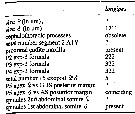|
|
 |
Fiche d'espèce de Copépode |
|
|
Harpacticoida ( Ordre ) |
|
|
|
Clytemnestridae ( Famille ) |
|
|
|
Clytemnestra ( Genre ) |
|
|
| |
Clytemnestra longipes Huys & Conroy-Dalton, 2000 (M) | |
| | | | | | | Syn.: | Clytemnestra scutellata : in material collected during Great Barrier Reef Expedition 1928-29 (stations 62, 65, 68). | | | | Ref.: | | | Huys & Conroy-Dalton, 2000 (p.24, Descr.M, figs.M); Huys & Boxshall, 2004 (p.278) |  issued from : Huys and Conroy-Dalton in Bull. nat. Mus. Lond., 2000, 66 (1). [p.23, Fig.14]. Male (from Great barrier Reef): A, habitus (dorsal); B, urosome (ventral); C, exopodite 3 of P2; D, P5 (anterior); E, right P6.
|
 issued from : Huys and Conroy-Dalton in Bull. nat. Mus. Lond., 2000, 66 (1). [p.24]. Male: armature formula P2-P4.
|
 issued from : Huys and Conroy-Dalton in Bull. nat. Mus. Lond., 2000, 66 (1). [p.45, Table 1]. Diagnostic characters. A1 = antennule; GDS = genital double-somite; AS = first abdominal somite. Measurements based on material examined in the publication.
| | | | | NZ: | 1 | | |
|
Carte de distribution de Clytemnestra longipes par zones géographiques
|
| | | | Loc: | | | E Australia (Great Barrier Reef).
Type locality: Great Barrier Reef. | | | | N: | 1 | | | | Lg.: | | | (931) M: 1,211; {M: 1,21} | | | | Rem.: | After Huys & Conroy-Dalton (2000, p.24) the male of this species differs from all known males in: 1- the ventral ornamentation pattern of the urosome, displaying spinules on all postgenital somites; 2- the extreme elongation of the P5 and P6. This species has the same swimming leg setal formula as C. setosa but, in addition to the characters listed , differs from the latter in body size and the presence of the proximal endite on the maxillary (Mx2) syncoxa.
Identification characters after G.A. Boxshall & S.H. Halsey (2004, p.278):
1- Exopod of P1 with 4 distal setal elements; female A1 7-segmented.
2- Exopod of P5 in both sexes armed with 5 setae; 3rd exopodal segment of P2 with total of 6 spines/setae.
3- 3rd exopodal segment of P3 and P4 each with total of 7 spines/setae.
4- Male P5 elongate, with apex of exopodal segment extending to posterior margin of 1st free abdominal somite; Mx2 with proximal seta on syncoxa representing endite. | | | Dernière mise à jour : 13/09/2015 | |
|
|
 Toute utilisation de ce site pour une publication sera mentionnée avec la référence suivante : Toute utilisation de ce site pour une publication sera mentionnée avec la référence suivante :
Razouls C., Desreumaux N., Kouwenberg J. et de Bovée F., 2005-2025. - Biodiversité des Copépodes planctoniques marins (morphologie, répartition géographique et données biologiques). Sorbonne Université, CNRS. Disponible sur http://copepodes.obs-banyuls.fr [Accédé le 24 décembre 2025] © copyright 2005-2025 Sorbonne Université, CNRS
|
|
 |
 |





